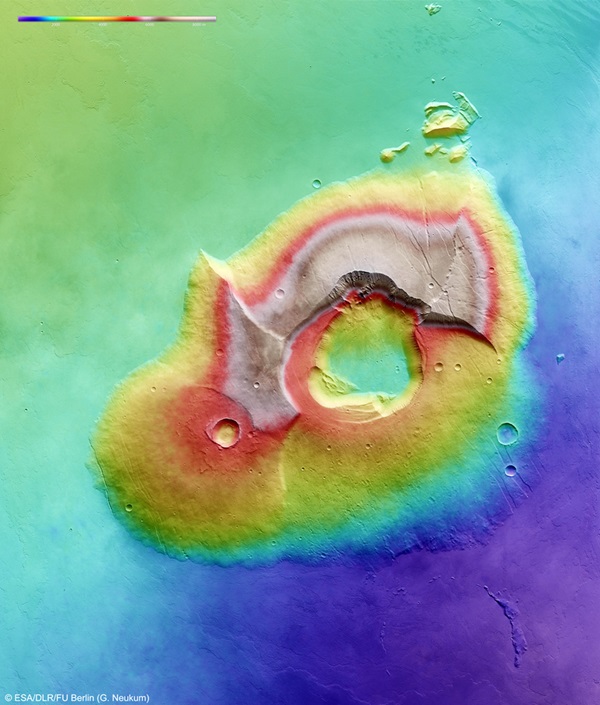By earthly standards, Tharsis Tholus is a giant, towering 5 miles (8 kilometers) above the surrounding terrain, with a base stretching over 100 by 80 miles (155 by 125 km). Yet on Mars, it is just an average-sized volcano. What marks it out as unusual is its battered condition.
Shown here in this image taken by the HRSC high-resolution stereo camera on the European Space Agency’s (ESA) Mars Express spacecraft, the volcanic edifice has been marked by dramatic events.
At least two large sections have collapsed around its eastern and western flanks during its four-billion-year history, and these catastrophes are now visible as scarps up to several miles high.
The main feature of Tharsis Tholus is, however, the caldera in its center. It has an almost circular outline, about 20 by 21 miles (32 by 34 km), and is ringed by faults that have allowed the caldera floor to subside by as much as 1.7 miles (2.7km).
It is thought that the volcano emptied its magma chamber during eruptions, and, as the lava ran out onto the surface, the chamber roof was no longer able to support its own weight. So, the volcano collapsed, forming the large caldera.
By earthly standards, Tharsis Tholus is a giant, towering 5 miles (8 kilometers) above the surrounding terrain, with a base stretching over 100 by 80 miles (155 by 125 km). Yet on Mars, it is just an average-sized volcano. What marks it out as unusual is its battered condition.
Shown here in this image taken by the HRSC high-resolution stereo camera on the European Space Agency’s (ESA) Mars Express spacecraft, the volcanic edifice has been marked by dramatic events.
At least two large sections have collapsed around its eastern and western flanks during its four-billion-year history, and these catastrophes are now visible as scarps up to several miles high.
The main feature of Tharsis Tholus is, however, the caldera in its center. It has an almost circular outline, about 20 by 21 miles (32 by 34 km), and is ringed by faults that have allowed the caldera floor to subside by as much as 1.7 miles (2.7km).
It is thought that the volcano emptied its magma chamber during eruptions, and, as the lava ran out onto the surface, the chamber roof was no longer able to support its own weight. So, the volcano collapsed, forming the large caldera.










